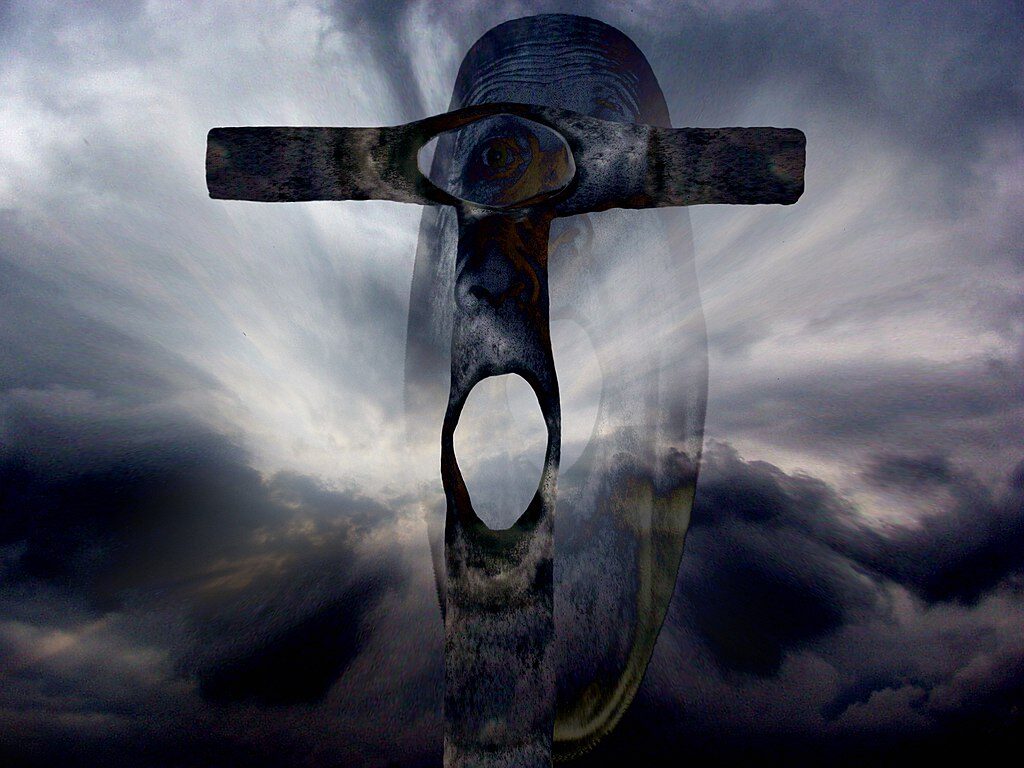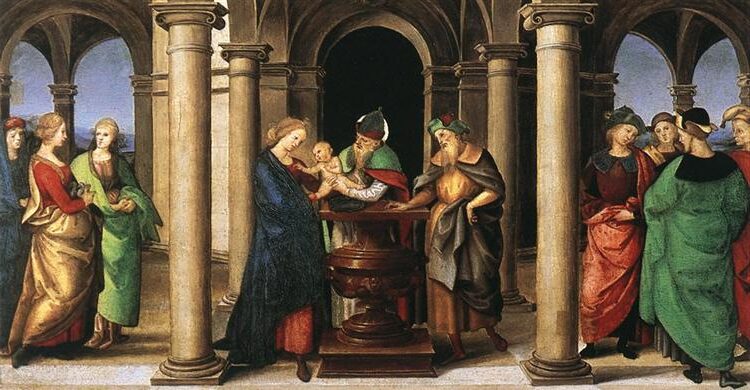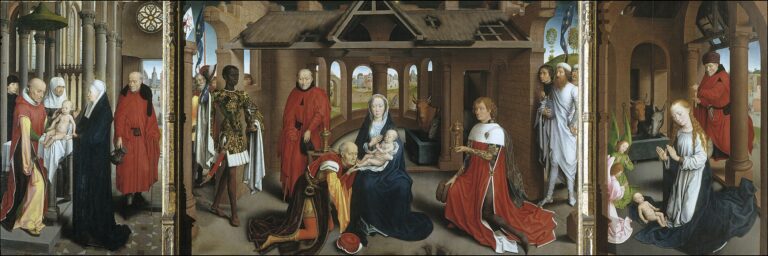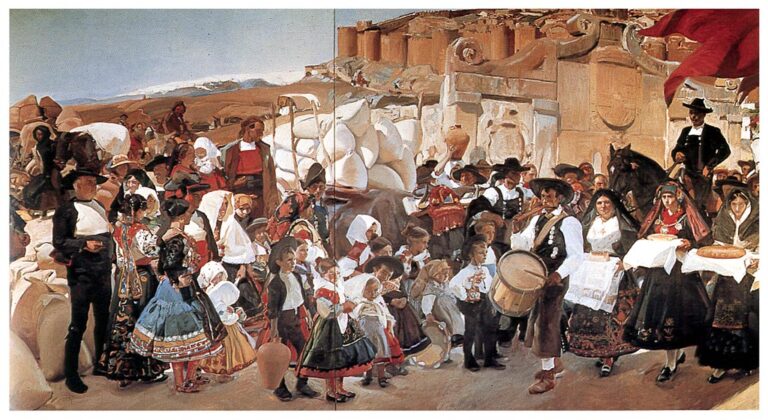Beksinski Art: Exploring the Surreal Masterpieces of a Visionary Artist
Born: February 24, 1929; Sanok, Poland
Death: February 21, 2005; Warsaw, Poland
Art Movement: Surrealism, Magic Realism
Nationality: Polish
Influenced By: Salvador Dalí and Max Ernst
Institution: Kraków University of Technology
Beksinski Art: Exploring the Surreal Masterpieces of a Visionary Artist
Life and Career of Zdzisław Beksiński
Zdzisław Beksiński was a master in several artistic disciplines. He was recognized for his dark and surrealistic style. He left a significant impact on the art world through his unique works and personal experiences.
Early Years in Poland
Zdzisław Beksiński was born on February 24, 1929, in Sanok, Poland. Growing up in a region rich in history and culture, he developed an interest in art at a young age.

A painting done in (1973) by Zdzisław Beksiński
He studied architecture at Kraków University of Technology, which influenced his attention to detail and structure in later works. Despite his training, his true passion lay in painting, drawing, and photography, where he found freedom to express his imagination.
Creative Evolution and Periods
Beksiński’s artistic journey evolved through distinct periods. Initially, he explored abstract styles but soon shifted to his trademark dark, dystopian themes. His early works often featured dreamlike settings with vivid details.
In the 1970s and 1980s, his paintings became more elaborate, marked by haunting figures and apocalyptic landscapes. This “fantastic” period defined his legacy, showcasing his skill in combining emotion with unsettling imagery.
Photography and Sculpture Contributions
In addition to painting, Beksiński was an avid photographer and sculptor. His photography captured unsettling compositions and bizarre juxtapositions. These images often conveyed feelings of isolation and introspection.
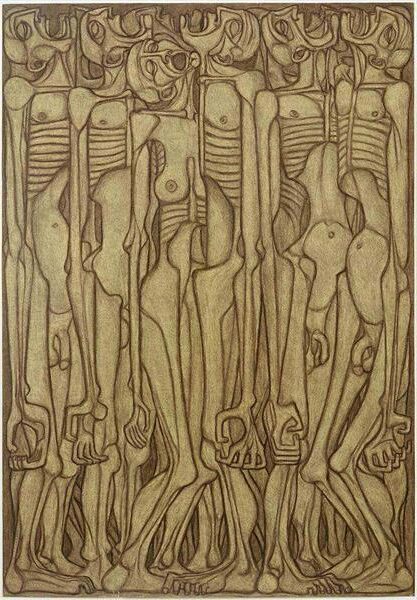
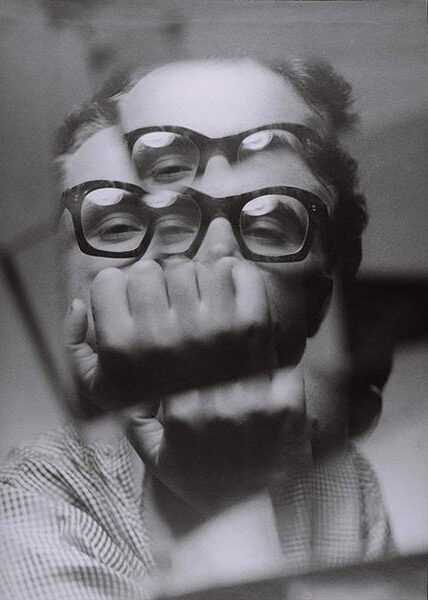
Meanwhile, his sculptures, though less prolific, reflected similar themes, utilizing materials like metal and wood. His multidisciplinary approach highlighted his ability to weave together different mediums, each reinforcing his thematic obsessions with decay and transformation.
Personal Tragedies and Impact on Art
Beksiński’s life was marked by personal tragedies that shaped his art. The death of his wife, Sonia, in 1998, followed by the suicide of his son, Tomasz, in 1999, deeply affected him.
These losses intensified the melancholic tones in his work, seen in more somber and introspective pieces. Such events added layers of depth to his already complex art, making it resonate with themes of grief and existential angst.
Distinctive Themes in Beksiński’s Art
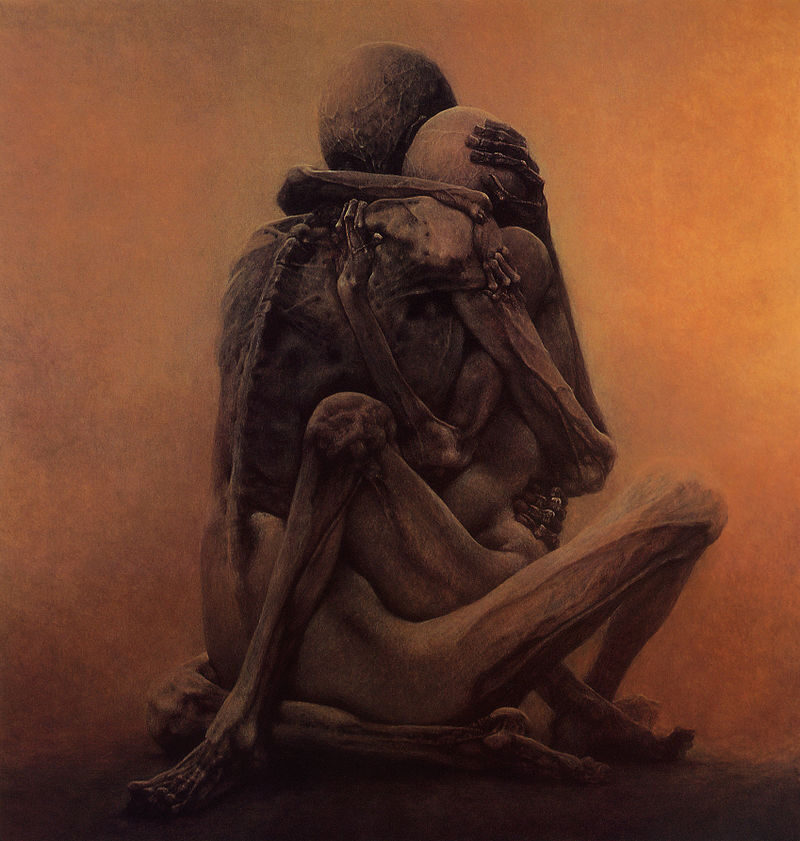

Zdzisław Beksiński’s artwork delves into the unsettling and surreal. His paintings are characterized by dystopian landscapes, a fascination with death and decay, and scenes filled with detailed and deformed figures. These elements create an atmosphere that is both haunting and captivating.
Dystopian Surrealism
Beksiński’s art often features dystopian landscapes. He is known for his imaginative, otherworldly settings that appear both dream-like and nightmarish. His surrealist style combines odd structures with desolate environments, creating a sense of eerie emptiness.
These barren landscapes often reflect bleakness and uncertainty, blending surrealism with a distinctly dystopian mood. Massive, crumbling structures often emerge from vast wastelands. The viewer is left with a sense of unease and intrigue. Each painting invites viewers to explore Beksiński’s unique artistic universe.
Death and Decay
The themes of death and decay are central to Beksiński’s work. Skulls, skeletons, and decaying human figures frequently appear in his paintings, symbolizing the inevitable decline of life.

A painting done in (1969) by Zdzisław Beksiński
This imagery gives his work a morbid beauty, compelling viewers to reflect on life’s fragility. The use of these elements is not meant to terrify, but instead to convey a melancholic sense of reality. Beksiński’s fascination with these themes seems to stem from an interest in the cycle of life and death, revealing a complex understanding of the darker aspects of existence.
Detailed Scenes and Deformed Figures
Beksiński’s attention to detail is evident in his intricate scenes filled with deformed figures. His characters often possess elongated limbs and distorted features, adding to the unsettling atmosphere.
This focus on body transformation highlights a departure from realism, embracing a more symbolic representation of human emotion and experience. The figures in his paintings appear almost grotesque but are crafted with a detailed precision that draws the viewer in. The careful rendering of these figures creates a powerful visual impact, forcing viewers to face the bizarre and unsettling world Beksiński so masterfully depicts.
Artistic Techniques and Styles
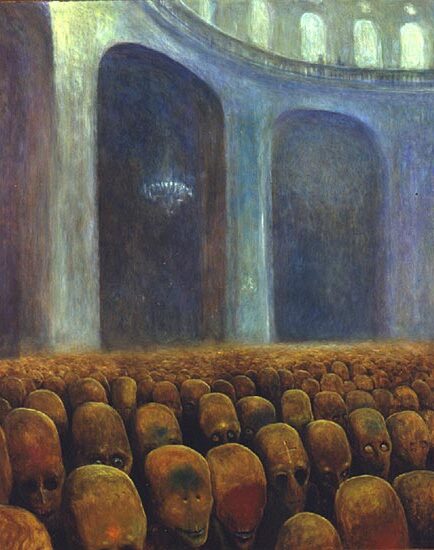
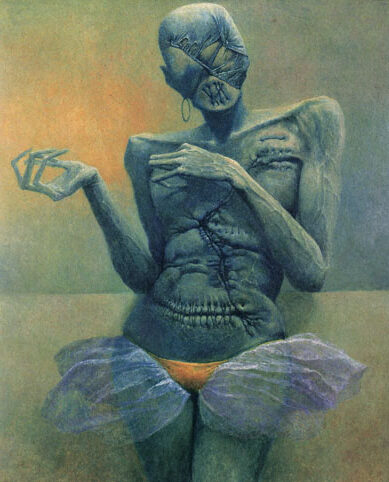
Zdzisław Beksiński is renowned for his dark and detailed surrealism, featuring dystopian imagery and haunting atmospheres. His artistic journey can be segmented into distinct periods, each showcasing unique techniques and themes such as vivid surreal landscapes and evolving abstract expressions.
The Fantastic Period
During the Fantastic Period, Beksiński embraced a vivid and unsettling surrealism. Oil painting was his primary medium, allowing him to create intricate textures and depth. His work during this time immersed viewers into nightmarish worlds, blending fantasy with gothic and baroque elements.
These paintings often depicted grotesque figures and dramatic scenes, capturing a sense of unease and mystery. Notably, he used shadows and contrasts to enhance the eerie feel while maintaining a fine balance between detail and obscurity. This period is characterized by the artist’s profound exploration of dreamlike and bizarre subject matter, which continues to captivate audiences with its unique and imaginative qualities.
Surreal Architecture and Landscapes
Beksiński’s art is also known for its surreal architecture and landscapes. He constructed scenes filled with decaying buildings and twisted structures, often emerging from barren, alien-like environments.
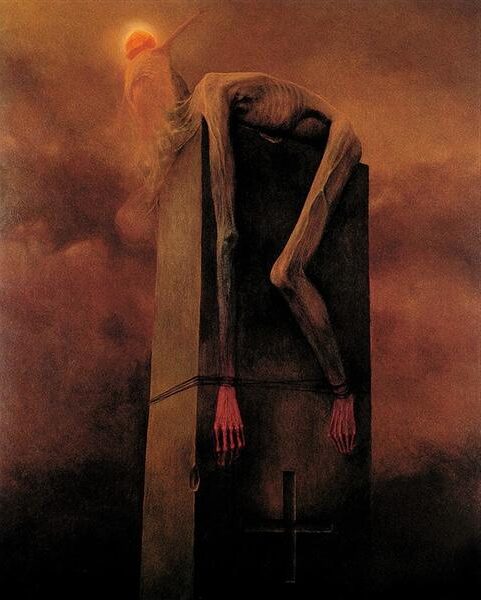
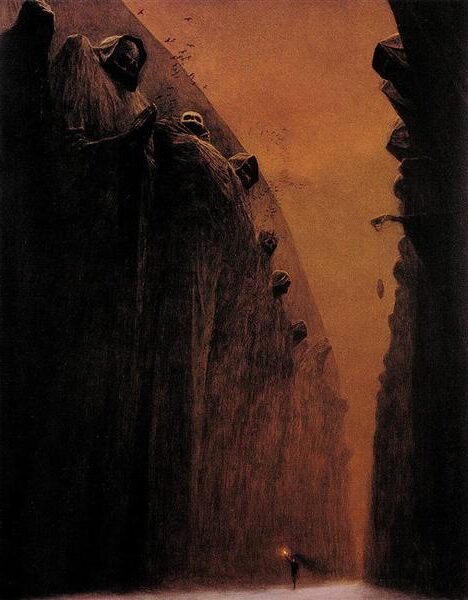
These settings evoke a sense of desolation and other-worldliness. By using techniques such as layering and cross-hatching, he achieved a remarkable realism in his imaginary worlds. The landscapes showcased barren terrains with jagged forms or skeletal remains, emphasizing a dystopian vision. His ability to fuse architectural elements with surreal landscapes created unique compositions that challenge the viewer’s perception of reality. Beksiński’s architectural elements are not merely backdrops but actively contribute to the narrative of his paintings.
Later Paintings and Abstract Style
In his later years, Beksiński’s style evolved into more abstract forms. He transitioned from oil to acrylic paints, adapting to this new medium with an abstract style characterized by vivid color blends and fluid forms.
This period saw a departure from the detailed grotesque imagery. Instead, he experimented with texture, form, and color without definitive shapes. Using abstract painting techniques, he focused on emotional impact rather than precise depiction. This shift marked significant changes in his artistic approach, revealing a broader conceptual focus. While still maintaining a sense of mystery, these later works highlight Beksiński’s versatility and adaptability as an artist.
Influence and Legacy in Contemporary Art
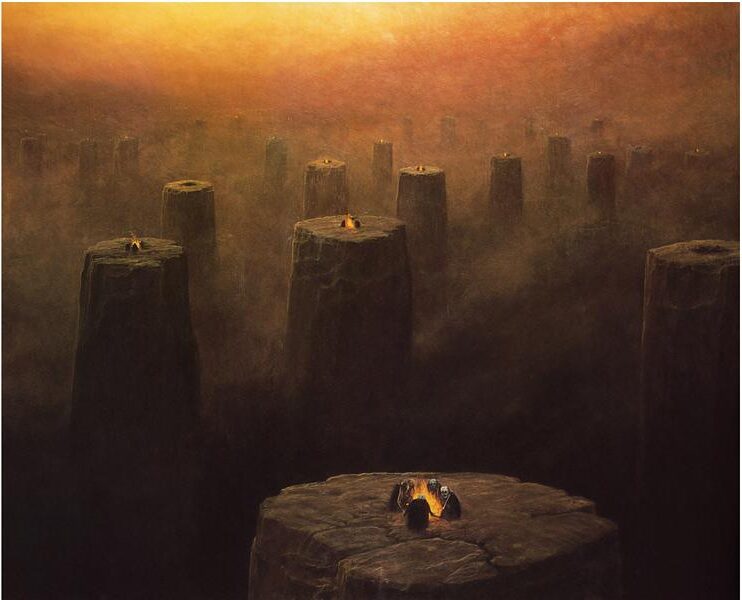
A painting done in (1978) by Zdzisław Beksiński
Zdzisław Beksiński’s work has left a deep and lasting impact on contemporary art. His distinctive style has shaped various artistic movements and continues to resonate across different media today.
The Polish Art Context
Within the landscape of Polish art, Beksiński holds a significant position. His work during the “fantastic period” from the late 1960s to the mid-1980s established him as a major figure in contemporary Polish art. This era, marked by intricate and surreal imagery, contributed to the development of a unique artistic voice in Poland. His paintings often depicted desolate landscapes and skeletal forms, which portrayed a darker side of human imagination and experience.
Influence on Horror and Macabre Art
Beksiński’s art profoundly influenced horror and macabre art globally. His depictions of dystopian worlds filled with eerie figures and unsettling environments inspired many artists in these genres.
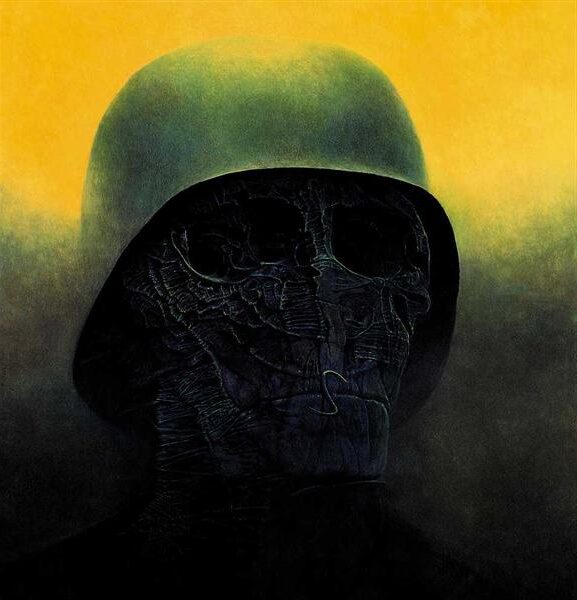
A painting done in (1985) by Zdzisław Beksiński
The haunting themes and grotesque imagery seen in his work have been mirrored in various forms of horror literature, films, and video games, emphasizing the connection between his visionary art and the broader realm of macabre expression.
Legacy in Digital Photography and Photomontage
His legacy extends into the realm of digital photography and photomontage, where his eerie and surreal compositions paved the way for new explorations in visual manipulation. Artists in these fields often draw upon his techniques to push boundaries and create dream-like or haunting images.
Beksiński’s influence is evident in the use of digital technologies to reimagine reality, showcasing how his ideas have transcended traditional painting to inspire modern photographic methods.
Cultural and Historical Contexts
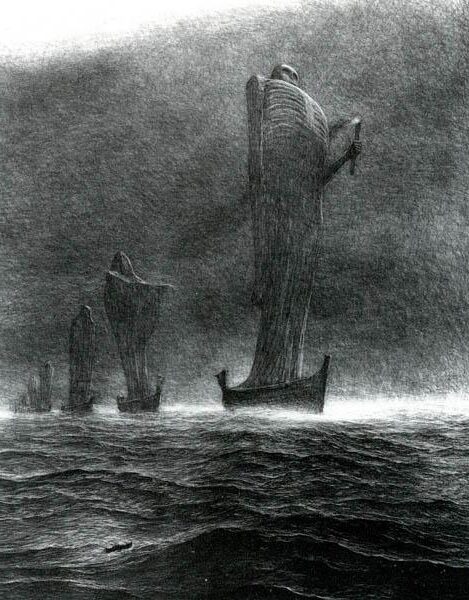
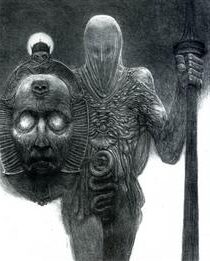
Zdzisław Beksiński’s art is shaped by intense historical experiences and deep cultural influences. His work often reflects themes of war and turmoil, pulling from the backdrop of World War II. Additionally, Beksiński’s exploration often moves between utopian realism and dystopian surrealism, creating a complex dialogue between hope and despair.
World War II Influence
Born in 1929, Beksiński grew up amid the chaos of World War II in Poland. The war left a profound impact on him, influencing both his life and his artistic vision.
This experience of conflict and destruction often emerges in his paintings through dark, haunting imagery and surreal landscapes.
Beksiński’s creations evoke scenes reminiscent of war-torn environments. They often include crumbling structures and desolate fields. These elements help to convey the sense of fear and uncertainty that many experienced during that time. The way he portrays devastation reflects his own encounters with loss and survival, painting a picture of a world in perpetual tension.
Utopian Realism vs. Dystopian Visions
Beksiński’s work navigates the tension between utopian realism and dystopian surrealism. He often contrasts idyllic visions with nightmarish landscapes.
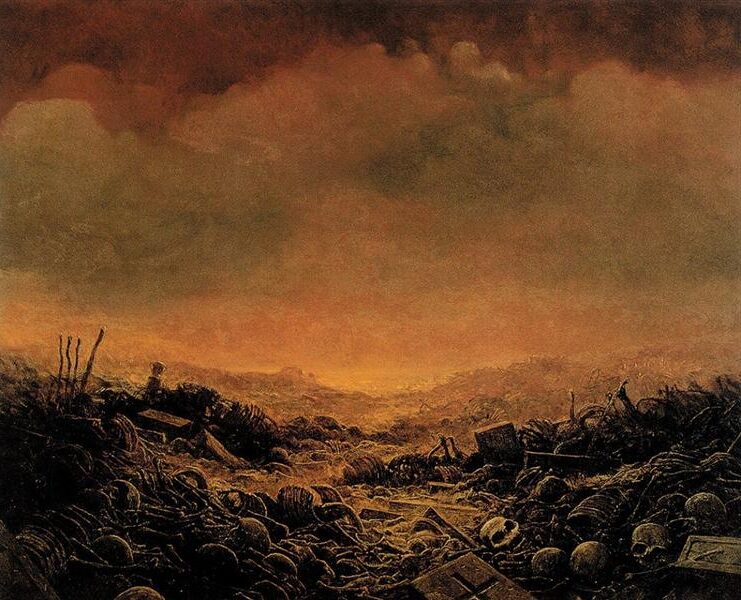
A painting done in (1971) by Zdzisław Beksiński
This duality is visible in his blend of realistic details with fantastical elements. While some aspects may hint at a utopian ideal, they are often overshadowed by unsettling, dystopian imagery.
His art frequently depicts hopeful scenarios twisted by troubling elements. This approach questions the reliability of utopian ideals. The eerie subjects in his paintings challenge viewers to find clarity and truth amid chaos.
Frequently Asked Questions
Zdzisław Beksiński was a pioneer in dystopian surrealism. His unique style and mysterious life lead to frequent questions about his work, influence, and legacy.
Where can I purchase Zdzisław Beksiński’s artwork?
Beksiński’s artwork can be purchased through established art galleries and auctions specializing in surreal and contemporary art.
Online platforms like Artnet and Sotheby’s sometimes list his pieces.
Which books catalog Beksiński’s art and his legacy?
Books such as “Beksiński 1” and “Beksiński 2” provide extensive catalogs of his work and insights into his vision. These collections often include reproduced images of his paintings and photographs.
How is Zdzisław Beksiński’s last name pronounced?
Zdzisław Beksiński’s last name is pronounced approximately as “Behk-sheen-skee.”
Are there any museums solely dedicated to Beksiński’s works?
The Historical Museum in Sanok, Poland, houses a significant collection of Beksiński’s pieces. This museum is dedicated to his work, showcasing many paintings and sculptures.
What is the estimated value of an original Zdzisław Beksiński painting?
An original Beksiński painting’s value can range significantly, often selling from tens of thousands to hundreds of thousands of dollars, depending on the work’s size, significance, and provenance.
What are the key influences in Beksiński’s art style?
Beksiński’s style was heavily influenced by dystopian themes, surrealism, and his personal experiences. He often portrayed haunting, nightmarish environments. These reflect a deep exploration of human and existential fears.

